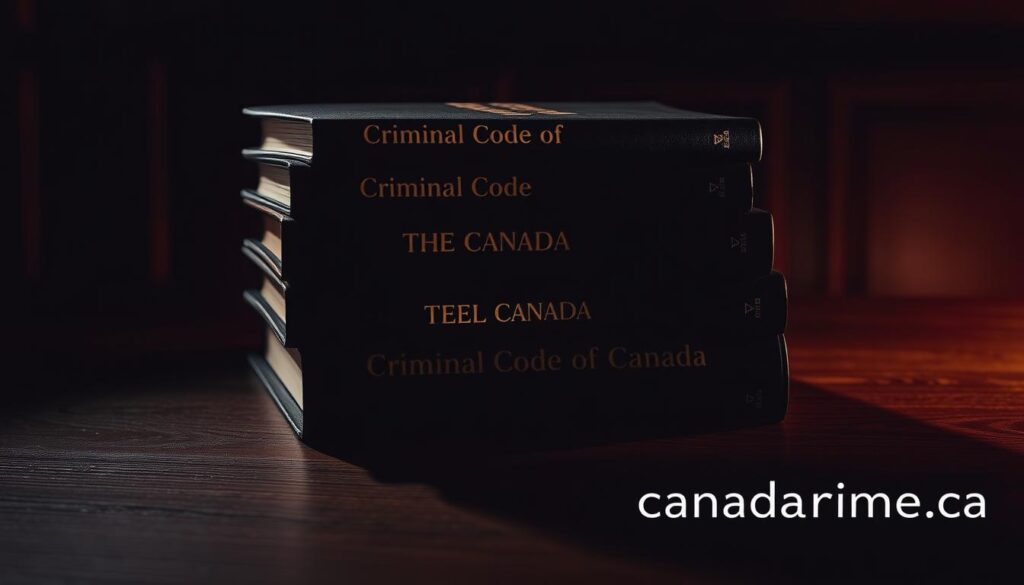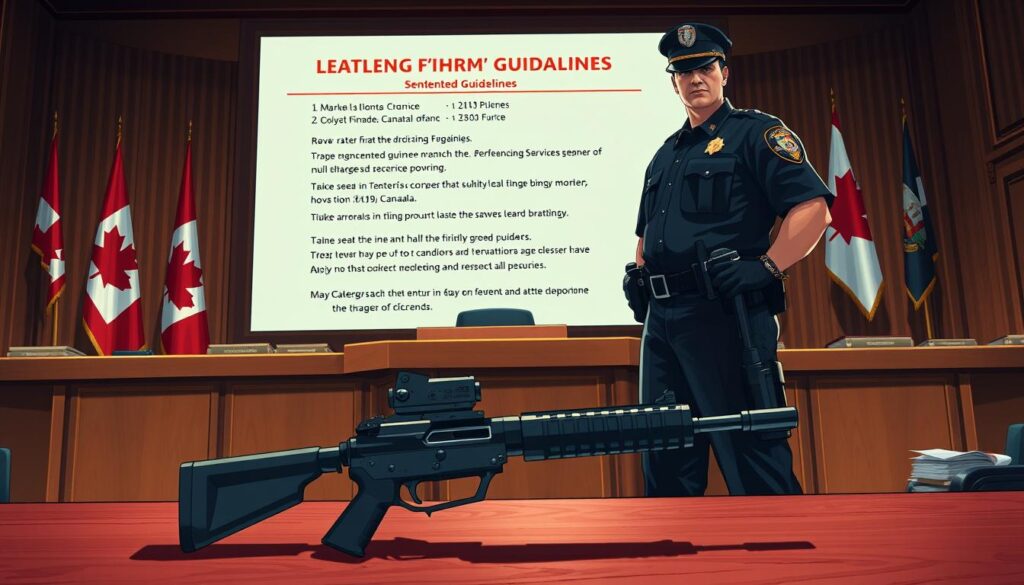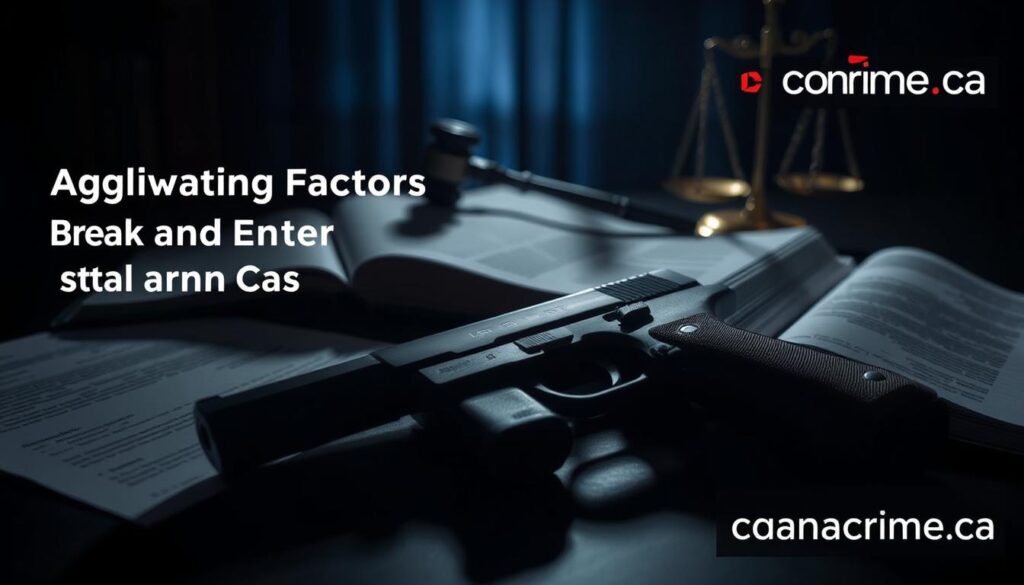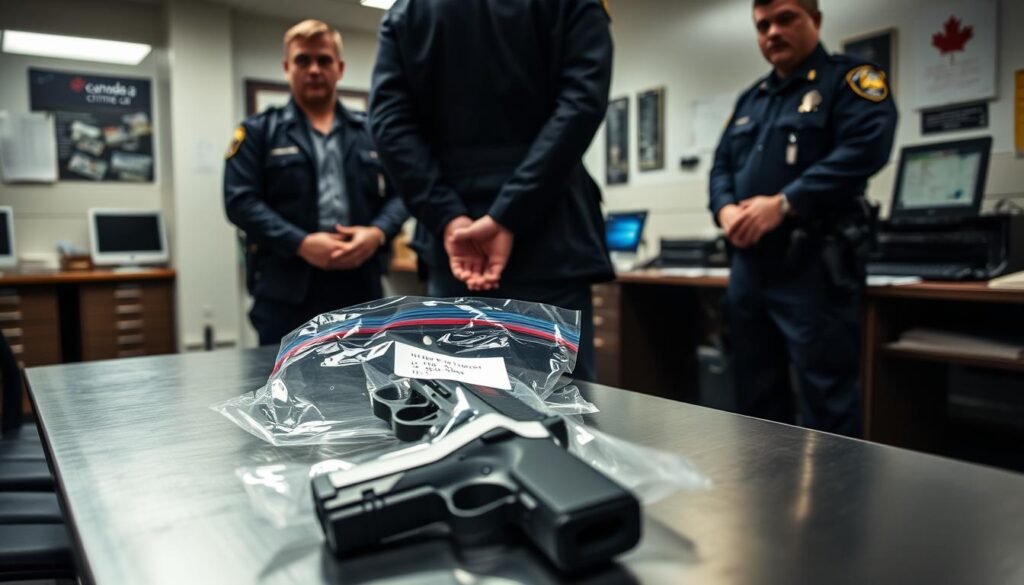Canadian law allows life imprisonment for breaking into premises to steal firearms. This severe penalty shows how seriously Canada treats these offenses.
The Criminal Code of Canada has specific rules for firearm theft through unlawful entry. These crimes face some of the toughest charges in the Canadian justice system.
This guide explores why stealing firearms criminal offense penalties are so harsh. Property crimes involving weapons create unique legal issues that courts take very seriously.
Knowing Canadian firearm laws is crucial if you’re facing charges or curious about this area. Authorities see these crimes as major threats to public safety.
This guide covers what prosecutors must prove and possible defense strategies. It also explains the serious consequences that follow convictions under these special laws.
The Crime of Break and Enter to Steal a Firearm
In Canada, stealing firearms through break-ins is a serious offense. It’s different from regular break-ins due to public safety concerns. Stolen guns often end up in illegal activities, causing more crime.
Canadian authorities take these cases very seriously. They know stolen firearms often show up in violent crimes later. This reflects the government’s goal to control gun access and keep weapons safe.
Legal Definition Under Canadian Law
Section 98 of the Criminal Code defines breaking in to steal a firearm. It’s a specific crime with three scenarios. The law covers all aspects of firearm-targeted break-ins.
- Breaking and entering with intent to steal a firearm located on the premises
- Breaking and entering and actually stealing a firearm from the location
- Breaking out of a place after stealing a firearm or after entering with intent to steal one
Prevalence and Statistics in Canada
Firearm theft through break-ins is an ongoing issue for Canadian police. These crimes happen in both cities and rural areas. The patterns and frequency vary by location.
Rural areas often see break-ins at homes where guns are stored. In cities, thieves target gun shops and shooting clubs more. Police track these incidents closely due to links with organized crime.
Many guns used in crimes were originally stolen in break-ins. This creates a pipeline where legal guns become illegal through theft. Different provinces have varying rates of these crimes.
Factors affecting firearm theft rates include:
- Prevalence of legal firearm ownership
- Proximity to trafficking routes
- Presence of organized crime groups
Criminal Code Provisions and Legislation
Canada’s legal framework tackles firearm-related offenses through the Criminal Code and Firearms Act. These laws work together to prevent, prosecute, and punish crimes involving firearms. They recognize the serious public safety risks of unauthorized firearm possession.
The Criminal Code treats break and enter to steal firearms with particular severity. This approach acknowledges the unique dangers that firearm theft poses to public safety. It goes beyond the risks of ordinary theft or break-and-enter crimes.

Section 98 and Related Provisions
Section 98 of the Criminal Code specifically targets break and enter to steal a firearm. It establishes this as a distinct criminal offense. This provision works with other Code sections to create a comprehensive legal framework.
Section 98(4) states that anyone committing this offense faces life imprisonment. This severe sentence highlights how seriously Canadian law views this crime.
The legislation borrows definitions from other parts of the Criminal Code. It also establishes unique elements specific to firearm theft. “Break” carries the same meaning as in Section 321.
“Place” is broadly defined to include various structures and vehicles. This expansive definition ensures the law applies regardless of where firearms are stored or stolen from.
Firearms Act Considerations
The Canadian Firearms Act provides context for Criminal Code provisions. It establishes the regulatory framework for legal firearm ownership, storage, and handling. Understanding these regulations is crucial when examining break and enter cases involving firearms.
The Firearms Act imposes strict requirements for secure firearm storage. This becomes relevant in break and enter cases. Proper storage may affect the accessibility of firearms to potential thieves.
It may also determine if the owner complied with legal storage requirements. In some cases, the owner could face separate charges for improper storage.
The Criminal Code and Firearms Act create a dual approach to firearm security. The Code punishes those who steal firearms. The Firearms Act aims to prevent unauthorized access through regulations.
| Legislation | Primary Focus | Key Provisions | Maximum Penalty |
|---|---|---|---|
| Criminal Code Section 98 | Break and enter to steal firearms | Specific offense definition, broad “place” definition | Life imprisonment |
| Criminal Code Section 348 | General break and enter | Base offense for all break and enter crimes | Varies by circumstance |
| Criminal Code Section 321 | Definition of “break” | Legal meaning of breaking for Section 98 | N/A (definitional) |
| Firearms Act | Regulation of firearms | Storage, licensing, and handling requirements | Varies by violation |
This framework shows Parliament’s aim to create a comprehensive approach to firearm security. Canadian law addresses prevention through the Firearms Act and punishment through the Criminal Code. It seeks to reduce firearm theft while ensuring severe consequences for offenders.
Elements of the Offense
Breaking and entering to steal a firearm has three key components. The Crown must prove each element beyond reasonable doubt. Failing to establish any element can result in acquittal for this charge.
Understanding these essential elements of Section 98 is crucial. The prosecution must show that each component meets legal standards. This applies to both legislation and case law.

Breaking and Entering Component
The first element involves proving an actual break and enter. This has specific definitions in the Criminal Code. Entry occurs when any body part or instrument crosses the threshold.
“Breaking” can be physical or constructive. Physical breaking involves forcible entry. Constructive breaking occurs when someone enters without permission through an existing opening.
Breaking and entering also includes gaining entrance through threats or collusion. Even entering through a temporary opening without lawful justification counts.
Firearm Theft Component
The second element involves proving firearm theft or intent to steal. This distinguishes the offense from general break and enter charges. It carries harsher penalties.
The Crown must show the item meets the legal definition of a firearm. The Firearms Act defines it as a weapon that can discharge projectiles.
Prosecutors must link the break-in to firearm theft or attempted theft. This connection is key to this specialized charge.
Intent Requirements
Proving intent is often the most challenging element. Prosecutors must show the break-in’s specific purpose was to steal a firearm. This differs from general theft intent.
Criminal intent for firearms theft can be proven through various evidence. Direct evidence might include statements indicating the purpose to obtain firearms. Circumstantial evidence could involve targeting known firearm storage areas.
Courts examine all circumstances to determine intent. They analyze the accused’s actions, targeted premises, and any pre-offense preparations. These factors help establish planning for firearm theft.
| Element | Legal Requirement | Evidence Types | Challenges in Proving |
|---|---|---|---|
| Breaking and Entering | Physical or constructive entry without permission | Witness testimony, security footage, physical evidence | Establishing unauthorized entry when no forced entry exists |
| Firearm Theft | Actual theft or intent to steal firearms | Recovered weapons, inventory records, fingerprints | Proving the item meets legal definition of firearm |
| Criminal Intent | Specific purpose to steal firearms | Statements, targeting patterns, preparatory actions | Distinguishing from general theft intent when no firearms taken |
Legal Penalties and Sentencing Guidelines
Canada’s Criminal Code sets strict sentencing guidelines for firearm theft. Break and enter to steal a firearm is among the most serious property crimes. The legal system treats these offenses harshly due to public safety risks.

Mandatory Minimum Sentences
Section 98 offenses don’t have specific mandatory minimums. However, related firearms offenses often do. If the stolen firearm is used in another crime, additional minimums may apply.
Break and enter to steal a firearm is always prosecuted as an indictable offense. This requirement signals the justice system’s serious approach to these cases.
Courts consistently impose substantial custodial sentences for these offenses. This reflects Parliament’s intention to deter individuals from introducing firearms into illegal markets.
Maximum Penalties
Section 98(4) of the Criminal Code states offenders are liable to imprisonment for life. This maximum penalty equals that of second-degree murder, highlighting the offense’s severity.
The potential life sentence shows Parliament’s view of firearm theft as a serious public safety threat. While sentences rarely reach this maximum, courts typically impose significant incarceration periods.
These severe penalties serve as punishment and deterrent against firearm theft. Courts recognize that stolen firearms often enter illegal markets and may fuel violent crimes.
Sentencing Factors Considered by Courts
Courts weigh numerous factors when sentencing for firearm theft. Your criminal history, especially previous weapons offenses, significantly impacts decisions. They also consider the apparent purpose for stealing the firearm.
Key factors include whether the firearm was loaded or stored with ammunition. The type and number of firearms taken also matter. Connections to organized crime or gang activity influence sentencing too.
Courts emphasize deterrence due to potential public safety implications. Aggravating factors like violence during the offense lead to harsher sentences.
Aggravating Factors in Break and Enter to Steal a Firearm Cases
Canadian law treats firearm theft severely. Judges consider specific factors when sentencing offenders. These factors can make punishments harsher. The Criminal Code outlines circumstances that courts must view as aggravating.

Use of Violence or Weapons
Violence during a break-in makes firearm theft more serious. Section 348.1 of the Criminal Code highlights this. It focuses on break-ins in occupied homes.
Courts give harsher sentences when violence or threats occur. This recognizes the trauma victims experience. It’s a violation of their safety and security.
Cases are particularly severe when weapons are used during the break-in. This creates a double threat to public safety. It shows a dangerous increase in criminal behavior.
Gang-Related Activities
Firearm thefts linked to organized crime face extra scrutiny. The Crown must prove the crime was for a criminal organization’s benefit. This makes the offense much more serious.
Gang-related thefts suggest a complex criminal operation. Courts know these stolen firearms often end up in other crimes. This creates more potential harm to public safety.
These cases often have stricter bail rules. The link between organized crime and gun trafficking is a serious threat to community safety. Courts address this with tougher sentences.
Prior Criminal History
Previous convictions greatly impact sentencing for firearm theft. Repeat offenders, especially those with weapon or violent offenses, face harsher sentences. Courts focus on specific deterrence for offenders showing similar behavior patterns.
Prior convictions suggest the person hasn’t changed. They may still be a risk to public safety. The impact is stronger when past offenses match the current charge.
A history of gun crimes with a new firearm theft charge almost guarantees a long prison sentence. It often reaches the maximum allowed penalty.
| Aggravating Factor | Legal Provision | Typical Sentencing Impact | Bail Implications |
|---|---|---|---|
| Violence During Break-in | Section 348.1 | 2-3 additional years | Significantly reduced chance of release |
| Gang-Related Activity | Section 467.14 | 3-5 additional years | Reverse onus provisions apply |
| Prior Weapons Convictions | Section 718.2(a) | 1-4 additional years per conviction | Substantially reduced chance of release |
| Multiple Firearms Stolen | Common law aggravating factor | 1-2 additional years | Moderately reduced chance of release |
Multiple aggravating factors in one case lead to much harsher sentences. A gang member with prior convictions using violence to steal guns faces severe punishment. This reflects the extreme danger such offenders pose to society.
Legal Defenses Available
Facing a break and enter charge for firearm theft? Know your legal defenses. The Canadian legal system offers several options. These could reduce charges or lead to acquittal.
The Crown must prove all offense elements beyond doubt. This creates opportunities for strong defense strategies.

Lack of Intent
A lack of intent defense can be powerful against firearm theft charges. The Crown must prove you meant to steal a firearm. This element is crucial to your defense.
Show you intended to steal other items, not firearms. You might face a less serious break and enter charge. Your lawyer can present evidence of your actions during the incident.
Mistaken Identity
Mistaken identity defenses challenge the Crown’s evidence about who committed the crime. This strategy works well when identification evidence is key. You can question eyewitness testimony, which can be unreliable.
Provide an alibi or evidence placing you elsewhere. Video footage or testimony can support this defense effectively.
Charter Rights Violations
Police might violate your rights under the Canadian Charter. This could exclude crucial evidence in your case. Common violations include unreasonable search, arbitrary detention, or denial of counsel.
Your lawyer can file to exclude evidence if rights were violated. This strategy can weaken the Crown’s case against you significantly.
Absence of Knowledge
Prove you didn’t know firearms were present at the location. This defense works well in cases with multiple participants. One person might know about firearms while others don’t.
Your actions and communications become important evidence. They can help establish this defense effectively.
| Defense Strategy | Key Elements | Potential Outcome | Evidence Required |
|---|---|---|---|
| Lack of Intent | No specific intent to steal firearms | Reduced charges | Behavior evidence, statements, target selection |
| Mistaken Identity | You were not the perpetrator | Complete acquittal | Alibi, video evidence, witness testimony |
| Charter Violations | Rights infringed during investigation | Evidence exclusion | Police reports, detention records, witness accounts |
| Absence of Knowledge | Unaware firearms were present | Reduced charges | Communications, relationship to co-accused, behavior |
The Crown’s Burden of Proof
The Crown’s burden of proof is crucial in firearm theft cases. In Canada’s legal system, prosecutors face tough challenges to secure a conviction. This principle safeguards individuals from wrongful convictions and ensures fair justice.
In criminal cases, defendants don’t have to prove innocence. The Crown must show guilt beyond a reasonable doubt. This high standard is the foundation of Canadian criminal justice.

Firearm theft cases require extra scrutiny due to their serious nature. Courts carefully examine evidence, recognizing the severe consequences of conviction. The prosecution must overcome significant hurdles in these cases.
Elements the Prosecution Must Establish
To win a firearm theft case, the Crown must prove specific elements. Each component needs independent confirmation. Failing to prove any element should lead to acquittal.
First, prosecutors must confirm the suspect’s identity. They typically use evidence like eyewitness accounts, forensic data, video footage, and cell phone records.
- Eyewitness testimony
- Forensic evidence (fingerprints, DNA)
- Video surveillance footage
- Cell phone location data
Second, they must prove a break-in occurred as defined by law. This includes showing physical forced entry or gaining access through threats or trickery.
Third, prosecutors must establish that a firearm was stolen or intended to be stolen. Proving intent can be challenging, especially if no firearm was taken.
Standard of Proof in Firearm Cases
“Beyond reasonable doubt” is the highest legal proof standard. It’s closer to absolute certainty than a balance of probabilities. If any reasonable doubt exists, a conviction can’t legally occur.
Courts apply extra scrutiny in firearm cases due to their seriousness. The Supreme Court emphasizes that evidence must be thorough and convincing to eliminate reasonable doubt.
| Element | What the Crown Must Prove | Potential Defense Challenges | Evidence Typically Used |
|---|---|---|---|
| Identity | You were the person who committed the offense | Mistaken identity, alibi evidence | Witnesses, DNA, fingerprints, video |
| Breaking & Entering | Unlawful entry occurred as defined by law | Lawful presence, permission to enter | Property damage, security footage, witnesses |
| Firearm Element | A firearm was stolen or intended to be stolen | Lack of knowledge, absence of intent | Recovered weapons, statements, circumstantial evidence |
| Mental State | You had the required criminal intent | Mistake of fact, intoxication (limited) | Planning evidence, statements, behavior |
Knowing the burden of proof helps if you’re facing charges. The Crown’s duty creates opportunities for your defense to challenge their case.
Raising doubt about any key element can prevent conviction. This is why expert legal representation is vital when facing serious charges.
What to Do If You’re Charged with Break and Enter to Steal a Firearm
A charge of break and enter to steal a firearm is serious. In Canada, it can lead to life imprisonment. Quick action is crucial to protect your rights and build a strong defense.
Taking the right steps can greatly affect your case’s outcome. Let’s look at what you should do if facing these charges.

Immediate Steps After Arrest
When arrested, use your right to remain silent. Only give basic identifying information. This protects you from self-incrimination.
The Canadian Charter guarantees your right to a lawyer without delay. Insist on this before answering any questions from police.
Note the details of your arrest and any searches. These may help with later challenges. Don’t discuss your case with anyone except your lawyer.
“The right to counsel is a fundamental right that exists to ensure that individuals who are arrested or detained have access to legal advice without delay.”
Finding Legal Representation
Getting an experienced lawyer is crucial for your defense. Look for one who knows firearms offenses and break and enter cases well.
If you can’t afford a lawyer, Legal Aid might help. They look at your finances and how serious the charge is.
Be honest with your lawyer about your case. Your talks are private, so you can speak freely.
Bail Considerations
For Section 98 charges, you may need to show why you should be released. This is likely if you were on release for another charge.
Several factors affect bail decisions in these cases:
| Bail Factor | Positive Influence | Negative Influence | Mitigation Strategy |
|---|---|---|---|
| Criminal History | Clean record or unrelated offenses | Prior similar charges or breaches | Character references, rehabilitation evidence |
| Community Ties | Stable employment, family support | No fixed address, limited connections | Surety arrangements, supervision plan |
| Case Strength | Weak Crown evidence, viable defenses | Strong evidence, caught in act | Challenge evidence validity, offer alternative narrative |
| Release Status | Not on bail for other matters | Already on release for other charges | Demonstrate compliance with previous conditions |
If granted bail, expect strict rules. These may include house arrest, curfews, and weapons bans. Breaking these rules can lead to more charges.
Case Precedents and Judicial Interpretation
Canadian court precedents are vital in break and enter firearm theft cases. They offer practical guidance on Section 98’s application. These interpretations can greatly influence your case’s outcome.
Courts have developed case law that clarifies offense elements. It also establishes important legal principles. Understanding these precedents is crucial for navigating this complex legal landscape.
Landmark Canadian Decisions
Key landmark firearm cases in Canada have shaped break and enter offense interpretations. The Supreme Court’s R v. Johnson ruling redefined “breaking” in legal terms.
It established that force isn’t always necessary for breaking. Entering through an open door without permission can constitute breaking legally.
Canadian courts require proof of specific intent to steal a firearm. This differs from general theft intent. Circumstantial evidence often establishes this specific intent.

Courts have addressed party liability in multi-participant cases. They’ve determined when accomplices share specific firearm intent. This is crucial when only one person physically took the weapon.
Recent Case Law Developments
Recent firearm theft case law refines Section 98’s practical application. Courts have addressed the Supreme Court’s Jordan decision impact on these charges.
This ruling set trial time limits. It has important implications for your right to a timely trial.
Charter challenges to investigative techniques are increasing in firearm theft cases. These often target search warrant validity, surveillance methods, and evidence handling.
- Search warrant validity
- Electronic surveillance methods
- Collection and handling of evidence
The judicial interpretation of Section 98 now covers new scenarios. These include theft of firearm parts, not just complete weapons.
Courts continue refining what legally constitutes a “firearm”. This includes non-functioning firearms, replicas, and partially assembled weapons.
Conclusion
Break and enter to steal a firearm is a serious property crime in Canada. Penalties can reach life imprisonment due to public safety concerns. These charges reflect the danger of stolen firearms entering illegal circulation.
Understanding Canadian gun laws is crucial if you’re facing such charges. The Crown must prove all elements beyond reasonable doubt. This high standard creates opportunities for effective defense strategies.
A conviction can impact your ability to travel and work in certain fields. It can also affect your rights. Seeking qualified legal advice is essential from the moment of arrest.
Your defense lawyer can help identify potential Charter violations. They can challenge evidence collection procedures or question the Crown’s burden of proof. These approaches have led to reduced charges or acquittals in many cases.
Each case has unique circumstances that require personalized legal analysis. Your prior record, manner of entry, and knowledge about firearms shape your defense strategy.
Professional legal representation is essential due to the high stakes involved. The complex mix of property crime laws and firearms regulations demands specialized knowledge. This expertise can make a critical difference in your case’s outcome.

